The Inspirations Behind Most Popular Fantasy Swords
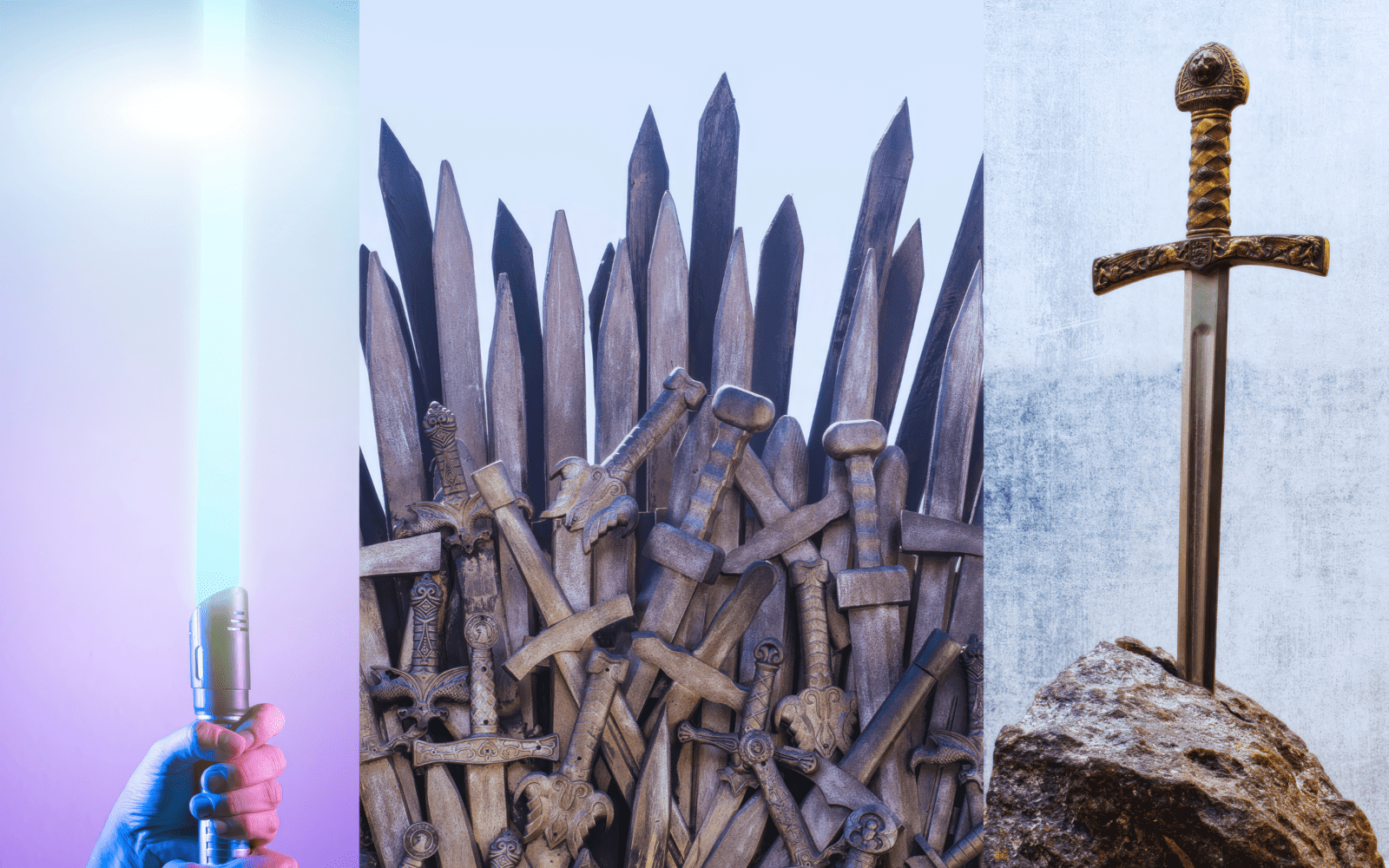
What’s in this article?
Many fantasy swords have a rich and compelling story of their own and have always been a main theme in several films, television series, anime, and video games. While some designers drew inspiration from historical swords, it is important to note that these adaptations often do not align with historical reality.
Let’s explore what was behind the design of the most popular fantasy swords seen on screen.
1. Star Wars Lightsaber
In Star Wars films, lightsabers are the weapons of both the Jedi and Sith. These weapons have blades made of laser energy capable of cutting through almost anything, including enemies, blast doors, and even deflecting incoming blaster bolts. In a Star Wars Featurette, writer-director George Lucas revealed that the original concept was for the Jedi knights to fight with just swords. However, he aimed to create a futuristic and technologically advanced version of a sword, resulting in a lightsaber.
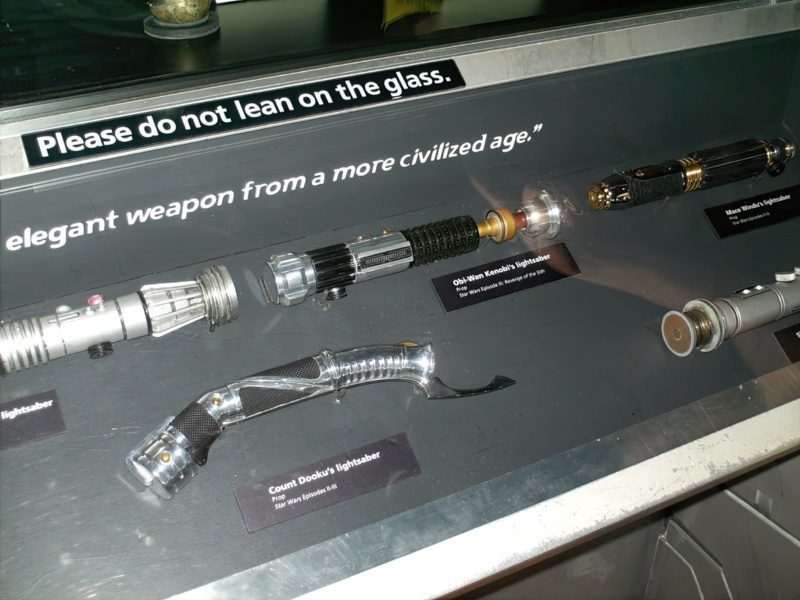
Initially, lightsabers were envisioned as extremely heavy weapons requiring the use of two hands. Over time, they became conceptually lighter, enabling single-handed use. This change was driven by the desire to make lightsaber duels faster and more intense. The design of lightsaber hilts was inspired by a vintage 1940s camera flashgun, also known as the Graflex handle.
The design of lightsabers evolved over the years, ranging from the typical single-ended design to dual-ended, piked, and folding types. In Star Wars: The Force Awakens, a Sith lightsaber featured mini-plasma-like blades as a crossguard. Crossguards historically served to protect a swordsman’s hand from an opponent’s blade.
Many believe incorporating crossguards into lightsabers could be practical due to the frequent hand amputations depicted in Star Wars films. However, some argue that weaponized crossguards might pose additional dangers to the wielder, particularly during complex fighting maneuvers and spins. Notably, the Sith lightsaber design appears crudely made, flawed, and would be overloaded if not for the side vents that create the quillons—arms of the crossguard.
2. King Arthur’s Excalibur
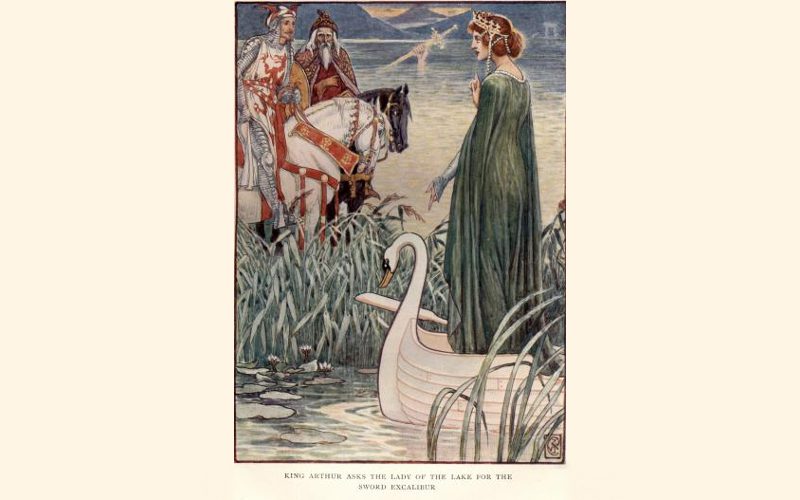
The Excalibur is the magical sword of King Arthur of Camelot, given by the Lady of the Lake. In the Arthurian legends, the legendary king could not be defeated as long as he carried it, as its scabbard protected him from all wounds.
The Excalibur is rooted in Celtic beliefs, traditions, and myths. The Celts endowed supernatural powers to the weapons of gods, kings, heroes, and warriors. Weapons were also given with personalities of their own, as well as names, pedigrees, and histories. Also, the Celts traditionally threw their weapons into ponds and lakes, likely associated with their sacrificial rituals.
Some believe the Excalibur may have been associated with the Caladbolg, a lightning sword of Irish hero Fergus mac Róich. The Irish Caladbolg translates as hard gap, which could mean cleaving through the hardship [of battle] or cleaving what is hard. It is also called caladbou, meaning hard fighter. The Irish Caladbolg has the same meaning as the Welsh Caledfwlch—an alternative name of Excalibur.
However, their similarities may be due to the common borrowing between Celtic languages. Some scholars suggest that the Irish Caladbolg and the Welsh Caledfwlch were likely generic terms for a sword, and the latter became Arthur’s sword in the British tradition.
3. Mulan’s Sword
The epic tale of China’s legendary warrior, Hua Mulan, has undergone adaptations spanning over a thousand years.
In Disney’s latest film Mulan, as with the original Ballad of Mulan, the protagonist disguises herself as a man in place of her ailing father and enlists in the army to fight invaders. At first glance, the sword wielded by Mulan in the film appears to be a jian sword characterized by its straight design.
However, upon closer examination, the sword features a straight, single-edged blade, classifying it as a dao. Typically, the term dao implies a curved Chinese saber, though it may also be a straight dao or straight-backed dao called zhibeidao. The earliest Chinese single-edged swords were zhibeidao, until the Mongols introduced the curved saber to China.
The Wētā Workshop, responsible for manufacturing the film’s weapon props, has revealed that they intentionally made the blade highly reflective due to a particular scene where Mulan looks at her reflection in the blade. Beyond this, they created a special sword twice the size to achieve the perfect reflection for that specific shot.
4. Game of Thrones Swords
Swords are the most prestigious weapons in the Game of Thrones, an American television series based on George R.R. Martin’s novel series A Song of Ice and Fire. Martin took inspiration from medieval and Renaissance European swords, especially when envisioning the swords of Westeros. Still, many sword designs were influenced by various designers responsible for the show’s iconic weapons.
Martin also incorporated a magical element into certain swords through Valyrian steel, a legendary and rare material capable of killing the White Walkers and their leader, the Night King. The swords featured in both the show and novels have names, with a select few made from Valyrian steel, including Ice, Longclaw, Oathkeeper, and Heartsbane.
Ned Stark’s Ice

Ice is the ancient greatsword of House Stark, owned by Ned Stark (also known as Eddard Stark), and the first Valyrian steel blade featured in the show. It reminds us of the two-handed greatswords of the 15th and 16th centuries, an extremely large sword with a massive blade, requiring two hands for proper wielding.
Historically, the large two-handed great swords have been known by various names, including doppelhänder (double-hander), bidenhänder (both-hander), zweihander (two-hander), montante, and spadone. Some were used on the battlefield against multiple opponents, to break up pikemen formations, or even as ceremonial bearing swords or parade swords (paratschwerter).
One of the most renowned battlefield uses of the greatsword was among the German Landsknechts mercenaries, specifically the doppelsöldners (double-pay men), who skillfully used the zweihander to breach enemy ranks. During the early Renaissance, pike formations were common, and the zweihander was used to cut off the shafts of long pole weapons.
Jon Snow’s Longclaw
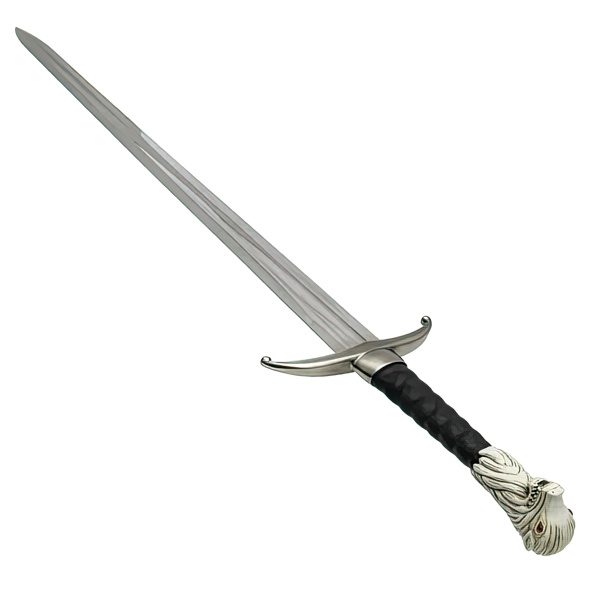
Jon Snow’s Longclaw was bequeathed to him by Jeor Mormont from House Mormont, the Lord Commander of the Night’s Watch. It originally had a bear-head pommel, the heraldic emblem of House Mormont. As a token of gratitude for Jon saving his life, Jeor altered the pommel into a dire wolf-head, the sigil of House Stark, then gifted it to Jon.
Historically, bastard swords, which emerged in the 15th and 16th centuries, are a type of longsword featuring hand-and-a-half grips, allowing it to be wielded with one or two hands. Additionally, the tradition of crafting sword pommels in the shape of animal or human heads originated in the region spanning present-day Iran and Eastern Turkey, dating back to around 1200 to 800 BCE.
Stylized animal heads on sword pommels also appeared later during the Viking Age, largely fading until their revival from the 16th to the 19th century. Lion-head pommels also gained popularity among British military swords during the 18th and 19th centuries.
Brienne of Tarth’s Oathkeeper

The Oathkeeper is a reforged Valyrian steel sword, melted from Ned Stark’s Ice. It originally belonged to Jaime Lannister, who later gave it to Brienne of Tarth when he sent her on a mission to find the Stark girls. In her dedication to upholding her vows and promises, Brienne named her sword Oathkeeper.
The Oathkeeper is notable for its elaborately decorated grips, quillons, and stylized animal-head pommel. Its hilt design is comparable to 16th-century European hunting swords, which were used for finishing off a wounded animal after being impaled by a spear or shot. These historical weapons sometimes feature engravings depicting scenes of hunting. Some American presentation swords and 19th-century British bandsmen swords also feature decorative hilts.
Jorah Mormont’s Heartsbane

The Heartsbane is a Valyrian steel sword that once belonged to House Tarly. Samwell Tarly gave the sword to Jorah Mormont in the fight against the White Walkers. Similar to Ned Stark’s Ice, the Heartsbane is a two-handed greatsword.
In a feature by CNET showcasing armorer Natalia Lee, it is revealed that the Heartsbane design draws inspiration from hunting rifles and Biblical Renaissance paintings. Given that the sigil of House Tarly is a striding huntsman, the sword’s shape mirrors that of a bow and arrow and is decorated with hunting motifs.
Arya Stark’s Needle

Arya Stark named her sword Needle, referencing her least favorite domestic craft: needlework. It was a gift from her half-brother Jon Snow, and its compact size makes it well-suited for a young individual like Arya.
The Needle has a thin, lightweight blade, likely inspired by European smallswords from the 17th and 18th centuries. Smallswords were civilian weapons and dueling swords designed for thrusting.
However, the Needle’s simple hilt design is more similar to a 17th-century pillow sword, so-called because of where it was kept. In the past, a pillow sword would hang above a headboard within easy reach, serving as a means of bedside defense against nighttime intrusion.
The Arakh of the Dothraki

The Arakh is the distinctive weapon of the Dothraki, a feared and ferocious warrior culture in the Game of Thrones. It features a crescent moon-shaped blade and an extended handle, making it half-sickle and half-sword. Warrior Daario Naharis of the Second Sons also wielded this weapon.
The Arakh, as depicted in the show, shares similarities with the ancient Egyptian khopesh of the Bronze Age. During Egypt’s New Kingdom period, the khopesh was a typical military weapon used for slashing in close-quarters combat.
5. Anduril Sword from The Lord of the Rings
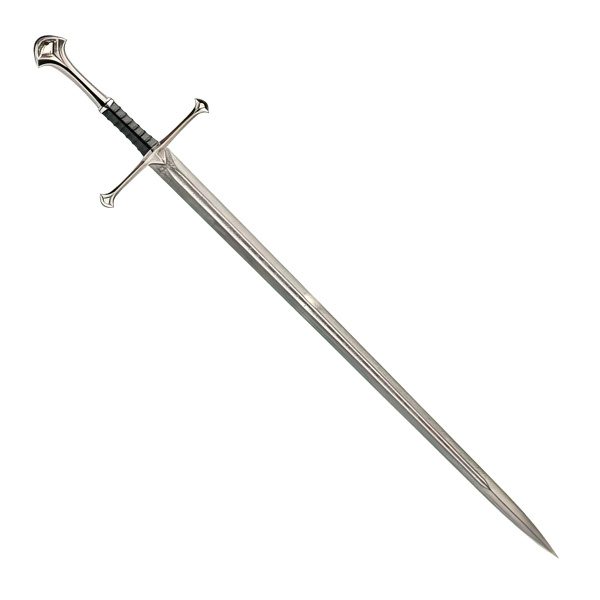
In the novel and film series The Lord of the Rings, Anduril was the sword of Aragorn II, who later became King Elessar Telcontar. The name Anduril translates as Flame of the West. In the story, Anduril was reforged from the shards of Narsil sword previously wielded by Isildur.
In the film, Anduril is portrayed as a longsword featuring a cruciform hilt. Historically, the longsword is most closely associated with medieval knights, who wielded it both on the battlefield and in duels. It was light enough to be used single-handedly, yet its extended grip allowed the use of both hands.
6. The Hobbit Swords
In The Hobbit, a prequel to The Lord of the Rings, several magical swords draw inspiration from ancient, medieval, and Renaissance designs while incorporating imaginative, non-historical elements. Among the most popular are Gandalf’s Glamdring and Bilbo’s Sting.
Glamdring
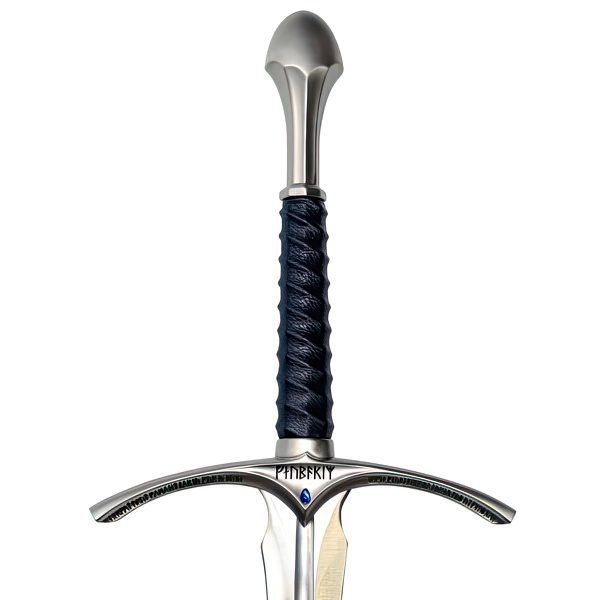
The Glamdring, also known as the Foe-hammer and the Beater, is the legendary sword wielded by the wizard Gandalf. In the films, Gandalf used his Glamdring sword to complement his staff, fighting with both weapons at once.
The Glamdring is depicted as a bastard sword with a hand-and-a-half grip, inscribed with runes, and a jeweled hilt. Throughout history, many swords bore talismanic inscriptions or symbols on their hilts or blades, designed to protect the wielder. Such practices can be seen on Islamic swords, medieval European swords, Japanese swords featuring horimono carvings, and even Chinese swords.
Sting
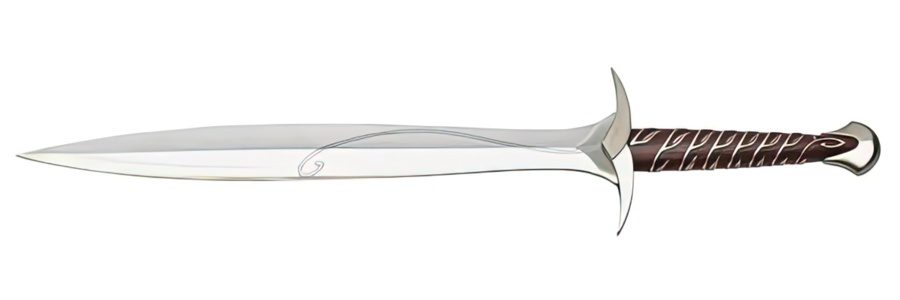
Sting is a short sword wielded by Bilbo Baggins and was later passed to his heir, Frodo Baggins. It is a magical sword that glows blue when it senses danger, especially when goblins or orcs are nearby. Originally, the concept for Sting drew inspiration from a 16th-century Swiss Holbein dagger, favored among the upper classes of society.
As portrayed in the films, Sting has a leaf-shaped blade similar to the historical Greek xiphos sword used by hoplites and Spartans. Historically, the xiphos served as the secondary weapon for Greek warriors in close-quarters combat. It was also the typical sword of both Classical and Hellenistic Greece.
Sting is also comparable to a specific type of Roman gladius short sword—the Mainz type—characterized by its classic waisted form. The Romans used the Mainz gladius during Augustus’ expansive territorial campaigns. The Celtic long sword, the Mindelheim type, also featured a leaf-shaped blade. However, Sting has a cruciform hilt reminiscent of medieval swords.
7. The Witcher Steel Sword
In television series The Witcher, the monster-hunter Geralt of Rivia wields a steel sword designed to dispatch both men and monsters. In the story, this sword is crafted from meteorite, making it more durable than traditional steel. Notably, Renfi’s brooch adorns the hilt to remind Geralt to avoid entanglements in the affairs of men because they often lead to their own personal pain.
The Witcher’s steel sword clearly draws inspiration from medieval longswords. However, actor Henry Cavill, who portrayed Geralt of Rivia, revealed that he asked to redesign the sword’s hilt. Instead of a typical cruciform hilt, he favored forward-angled quillons (the arms of the crossguard) to enable him to flick it through his wrist.
8. Hattori Hanzo Sword
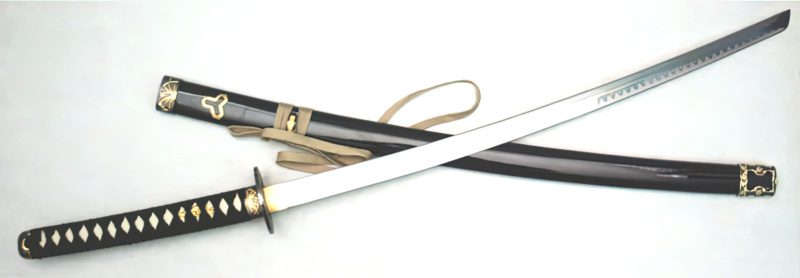
In the Kill Bill film series, the Hattori Hanzo sword served as the deadly weapon of the Bride, later known as Beatrix Kiddo (played by Uma Thurman). It draws inspiration from the katana sword wielded by the samurai warriors of feudal Japan and features distinctive elements adapted to the film. Notably, its blade features a foo dog carving, the mark of the master swordsmith Hattori Hanzo, who forged the sword.
However, historical Hattori Hanzo was not a swordsmith but rather a ninja or a samurai. Additionally, the name Hattori served as a family name, while Hanzo was a title or position given to the head of the Hattori family of Iga province in Japan, as each successor inherited the role from his predecessor. In this context, Hattori Hanzo simply means Head of the Hattori Family.
Several individuals had the name Hattori Hanzo, spanning generations from grandfather to grandson. Some historians believe that the first Hattori Hanzo, also known as Hattori Yasunaga, was a ninja leader of the family. However, his sons and grandsons served as samurai during the Sengoku and early Edo periods.
9. Sakabato from Rurouni Kenshin
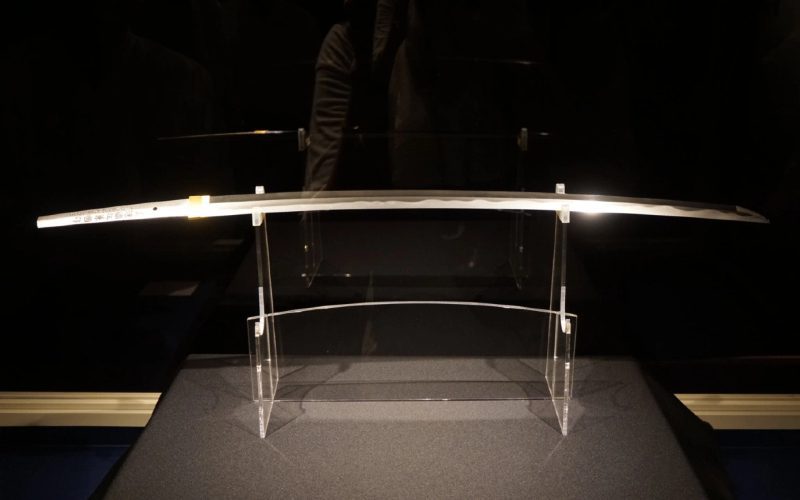
The sakabato is the reverse-edged katana popularized by the manga and anime series Rurouni Kenshin (also known as Samurai X), which was later adapted into a film series. Unlike the historical katana, the fictional sakabato has a blunt edge on the outward curve of the blade facing the opponent and a cutting edge on the inward curve facing the wielder.
The idea behind a reverse-edged katana is to incapacitate enemies without killing them. In the story, the protagonist, Himura Kenshin, is a former assassin who has sworn off killing. Master swordsmith Arai Shakku forged the sakabato to honor the peacetime that the Meiji era would bring.
While the sakabato or reverse-edged katana is fictional, swordsmith Kanekuni Ogawa created the first real-life version of the sword. Similar to traditional Japanese swords, this real-life version features a genuine hamon, or temperline pattern, though it appears on the cutting edge of the inward blade curve. Also, the fictional Arai Shakku’s death poem is inscribed on the sword’s tang.
10. Zatoichi’s Sword Cane
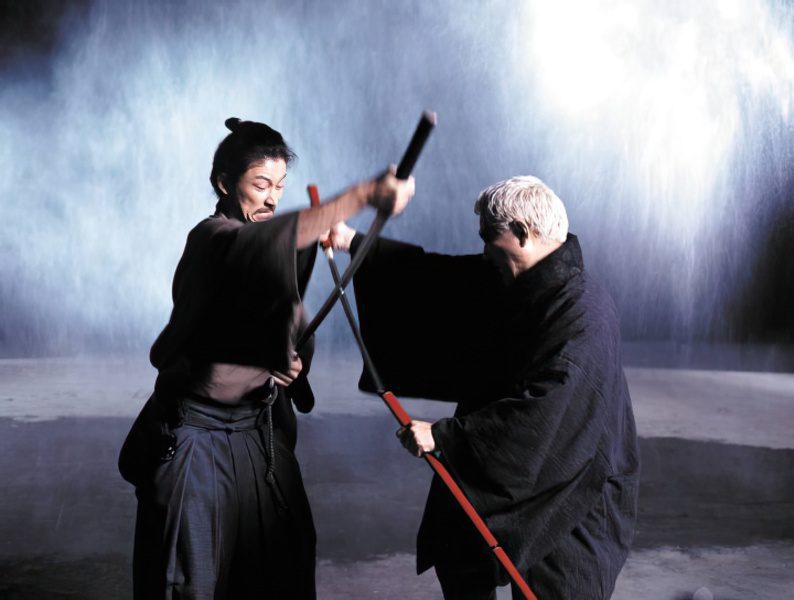
In Japanese films, Zatoichi is a blind swordsman who wields a sword cane to protect the innocent and fight injustice. The name Zatoichi is derived from Zato-No-Ichi, meaning Ichi the Masseur. In feudal Japan, blind people often served as masseurs, yet Zatoichi’s combat skills enabled him to rise above the class restraints of Japanese society.
Zatoichi’s sword cane draws inspiration from the shikomizue, a Japanese sword mounting that disguises a concealed blade within an ordinary wooden walking stick. The shikomizue gained popularity towards the end of the Edo period and in the early Meiji period, as the ban on wearing swords in public created a demand for concealed weapons.
However, the term shikomizue may also refer to concealed daggers, spearheads, hooks, chains, arrows, climbing aids, and even poison disguised as walking sticks or staffs. The shikomizue was popular among ninjas, assassins, and other criminals. In fact, the shikomizue is a variety of shinobi-zue weapons used by ninjas.




